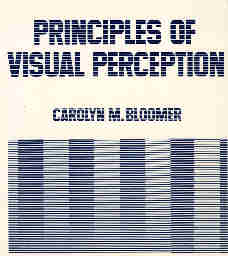On page 9 she gives a suggestion for an exercise involving cutting out pictures and words,
turning them over then selecting a picture and word at random and noticing the meanings which
result.
As she goes on to explain, it is the meaning-making function of the mind that is at work in
this simple exercise: the same function that is activated during phrenology, palmistry, astrology, I
Ching, and Tarot readings. It is a scientifically-grounded approach to explaining these various
means of divination to naive beginners. This is a first step, not a complete explanation.
Several important concepts of visual perception that she explains are:
Closure — the process of establishing the meaning of a visual
stimulus. Fine Art artists strive for intermediate
closure (not too fast, nor too slow). Commercial artist
strives for immediate closure. (One must recognize a
STOP sign very quickly on a public street, but a Dali
stop sign in a painting may take a while to sort out.)
Constancy — how the images perceived by the eyes maintain their
real-world sizes in proportion to their retina-impinged
image sizes. This is the reason that artists use pencils
in their extended arms: to gauge sizes so as to avoid
the size constancy problem.
Grouping — demonstrated by the triangle grouping on page 41. In
a uniform field of triangles, the eye/mind tries to form
groupings, but is doomed to failure. Artists like
Yaacham Agam use this grouping concept to create
visually interesting artworks from abstract geometric
shapes.
Pregnant Moment — the pregnant moment concept, in which action is
represented not at its climax, but at a moment just
before the climax.
The last three chapters are very handy for prospective artists and contain considerable
guidance on how to mix paints, select colors, avoid size/color constancy problems, and how to
establish closure.
May you, as I do, deem this book to be a worthy addition to any artist's library.
~^~
Any questions about this review, Contact: Bobby Matherne
~~~~~~~~~~~~~~~~~~~~~~~~~~~~~~~~~~~~~~~~~~~~~~~~~~~~~~~~~~

 == == == == == == == == == == == == == == == ==
== == == == == == == == == == == == == == == ==
22+ Million Good Readers have Liked Us
22,454,155
as of November 7, 2019
Mo-to-Date Daily Ave 5,528
Readers
For Monthly DIGESTWORLD Email Reminder:
Subscribe! You'll Like Us, Too!
== == == == == == == == == == == == == == == ==
Click Left Photo for List of All ARJ2 Reviews Click Right Bookcover for Next Review in List
Did you Enjoy this Webpage?
Subscribe to the Good Mountain Press Digest: Click Here!


CLICK ON FLAGS TO OPEN OUR FIRST-AID KIT.
All the tools you need for a simple Speed Trace IN ONE PLACE. Do you feel like you're swimming against a strong current in your life? Are you fearful? Are you seeing red? Very angry? Anxious? Feel down or upset by everyday occurrences? Plagued by chronic discomforts like migraine headaches? Have seasickness on cruises? Have butterflies when you get up to speak? Learn to use this simple 21st Century memory technique. Remove these unwanted physical body states, and even more, without surgery, drugs, or psychotherapy, and best of all: without charge to you.
Simply CLICK AND OPEN the
FIRST-AID KIT.

Counselor? Visit the Counselor's Corner for Suggestions on Incorporating Doyletics in Your Work.

All material on this webpage Copyright 2019 by Bobby Matherne





